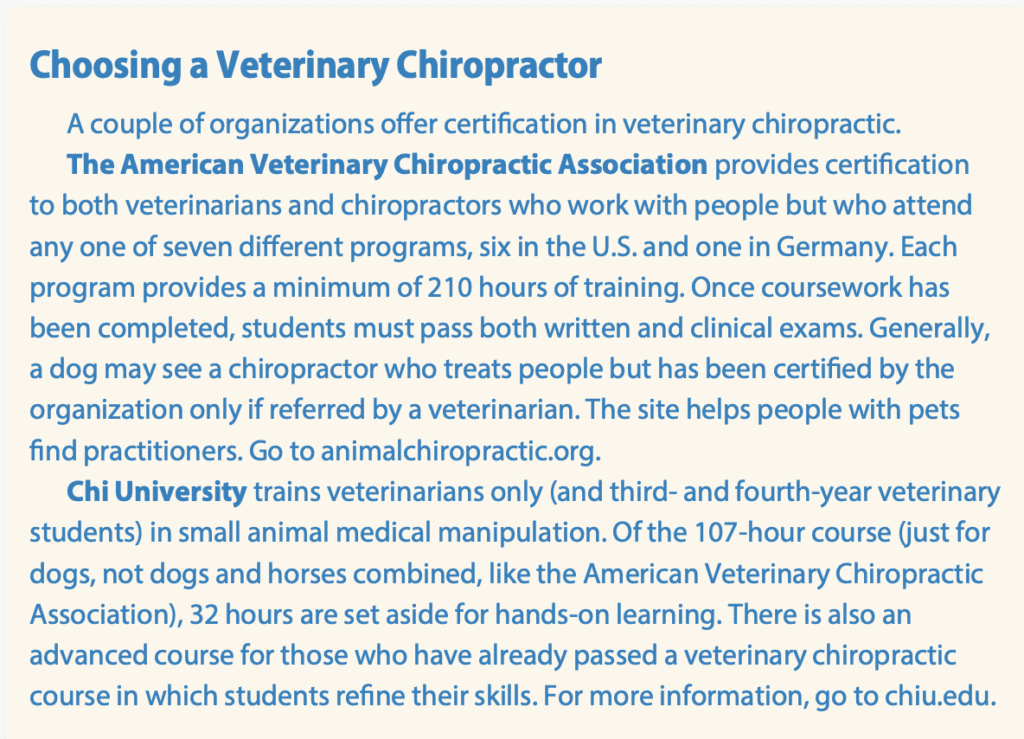“There’s a patient I’m seeing right now, an 8-pound Chihuahua who has horrible neck pain,” says Alicia Karas, DVM, “but in one session I can turn him from a hunched, tense mess to a head-up, tail-wagging dog. He just unfolds. When you see an animal transform from miserable and quivering to relaxed and happy, it means everything. I can give a dog pain medication,” she says, “but imagine being able to do that with your hands.”
Dr. Karas, a board-certified veterinary anesthesiologist who specializes in pain management and teaches the next generation of animal doctors at the Tufts Cummings School of Veterinary Medicine, is talking about chiropractic, commonly known in veterinary circles as medical manipulation. “The premise behind chiropractic,” she explains, “is that you have subtle changes in the way that your bones relate to each other. They’re just a little off, out of whack. It’s called a subluxation. It’s not something you would see on x-ray, but you may have horrible pain because the misalignment can be pinching a nerve.” Often, but not always, the bones involved are the bones of the spine, which are known as the vertebrae.
To fix the misalignment, or subluxation, the practitioner reorients the two bones through manipulation of the joint that connects them to each other, performing a high-velocity, low-amplitude thrust. It goes very fast (high velocity) but with very little movement on the part of the chiropractor (low amplitude). The move causes a temporary relaxation of muscles in the area that allows the two bones to come back into alignment.
“It’s so fast that it’s startling,” the doctor says. “You hear a noise a lot of times. The relief is instantaneous, although there’s a little bit of soreness afterwards. The body has been holding itself in one position to cope with something like a muscle spasm, and now it’s free, and the dog is moving around. The muscles realize, ‘Oh, I need to let go of that.’ Other muscles say, ‘Oh, I need to step up and help that.’ The adjustment is what can cause some soreness — but the pain is gone.” The same is true for people who go for chiropractic care.
Chiropractic doesn’t always start with thrusts. The little Chihuahua with neck pain (perhaps from a series of complicated dental procedures, but the cause is not clear) was in such agony that Dr. Karas says, “At first I couldn’t touch his neck. I began with massage, and then acupuncture.” It took a couple of sessions for her just to be able to put her hands on his neck to see where the pain was coming from. Even when the dog became more comfortable, she made adjustments in his back and spine to relieve his neck pain rather than in the neck itself.
That’s because sometimes chiropractic adjustment takes place on a part of the body far from the pain in order to treat what’s wrong. “I’ve had dogs that were lame, and the problem is assumed to be somewhere in their spine,” Dr. Karas says. “But it might be that a thrust is needed in a toe. While people walk on their feet, dogs walk on their toes. I’ve adjusted a toe, and all of a sudden the lameness goes away.” Similarly, she says, it could be a misalignment in the legs that’s causing a problem rather than in the spinal column itself.
Gaining acceptance in the veterinary community
Though some people perceive chiropractic as “kooky,” its first recorded use in people was documented in China almost 5,000 years ago. It made its way to North America in 1895. And since 1989, more than 1,400 doctors have been certified by the American Veterinary Chiropractic Association to practice on animals. Certification by that group requires 210 hours of training and continuing education for recertification every three years. Other organizations also offer veterinary chiropractic training. (See box on page 5.)
It must be stated that gold standard proof of chiropractic’s efficacy in treating pain is sorely lacking. “There have been some studies,” Dr. Karas says, “but most of the research has been in horses.” Controlled clinical trials involving dogs have not tested chiropractic against other pain remediation therapies head to head, nor has potential harm from the bodily manipulations practiced by veterinary chiropractors been subject to adequate scrutiny.
But the anecdotal evidence has been compelling enough that the American Veterinary Medical Association lists chiropractic as both a complementary and alternative treatment. And many pet health insurers are putting their money where veterinary chiropractors’ hands are, reimbursing for chiropractic treatment of dogs.
Chiropractic doesn’t necessarily replace other pain therapies, Dr. Karas says, and “it’s not the answer for everything.” But it could prove particularly useful when traditional treatments provide only partial relief, or very little relief. She likes, too, that it can sometimes do away with pain rather than simply mask it. “It’s a modality that may actually fix pain as opposed to simply medicating a dog to allow him to cope with it,” she says. Medications are of course sometimes indicated, she notes. “But imagine if you can make chronic pain actually go away.”






